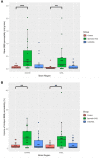Microglial activation and blood-brain barrier permeability in cerebral small vessel disease
- PMID: 34000009
- PMCID: PMC8874873
- DOI: 10.1093/brain/awab003
Microglial activation and blood-brain barrier permeability in cerebral small vessel disease
Abstract
Cerebral small vessel disease (SVD) is a major cause of stroke and dementia. The underlying pathogenesis is poorly understood, but both neuroinflammation and increased blood-brain barrier permeability have been hypothesized to play a role, and preclinical studies suggest the two processes may be linked. We used PET magnetic resonance to simultaneously measure microglial activation using the translocator protein radioligand 11C-PK11195, and blood-brain barrier permeability using dynamic contrast enhanced MRI. A case control design was used with two disease groups with sporadic SVD (n = 20), monogenic SVD (cerebral autosomal dominant arteriopathy with subcortical infarcts and leukoencephalopathy, CADASIL), and normal controls (n = 20) were studied. Hotspots of increased glial activation and blood-brain barrier permeability were identified as values greater than the 95th percentile of the distribution in controls. In sporadic SVD there was an increase in the volume of hotspots of both 11C-PK11195 binding (P = 0.003) and blood-brain barrier permeability (P = 0.007) in the normal appearing white matter, in addition to increased mean blood-brain barrier permeability (P < 0.001). In CADASIL no increase in blood-brain barrier permeability was detected; there was a non-significant trend to increased 11C-PK11195 binding (P = 0.073). Hotspots of 11C-PK11195 binding and blood-brain barrier permeability were not spatially related. A panel of 93 blood biomarkers relating to cardiovascular disease, inflammation and endothelial activation were measured in each participant; principal component analysis was performed and the first component related to blood-brain barrier permeability and microglial activation. Within the sporadic SVD group both hotspot and mean volume blood-brain barrier permeability values in the normal appearing white matter were associated with dimension 1 (β = 0.829, P = 0.017, and β = 0.976, P = 0.003, respectively). There was no association with 11C-PK11195 binding. No associations with blood markers were found in the CADASIL group. In conclusion, in sporadic SVD both microglial activation and increased blood-brain barrier permeability occur, but these are spatially distinct processes. No evidence of increased blood-brain barrier permeability was found in CADASIL.
Keywords: CADASIL; blood–brain barrier; cerebral small vessel disease; lacunar stroke; neuroinflammation.
© The Author(s) (2021). Published by Oxford University Press on behalf of the Guarantors of Brain. All rights reserved. For permissions, please email: journals.permissions@oup.com.
Figures



Comment in
-
Microglial activation and blood-brain barrier leakage: chicken and egg?Brain. 2021 Jun 22;144(5):1284-1285. doi: 10.1093/brain/awab149. Brain. 2021. PMID: 34028556 Free PMC article.
References
-
- Jokinen H, Schmidt R, Ropele S, et al. Diffusion changes predict cognitive and functional outcome: The LADIS study. Ann Neurol. 2013;73:576-583. - PubMed
Publication types
MeSH terms
Grants and funding
LinkOut - more resources
Full Text Sources
Other Literature Sources
Medical

